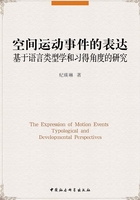
Acknowledgments
This study has grown out of the research I conducted in the past several years at the University of Cambridge, King's College London and Shenzhen University. My gratitude goes to my supervisors, mentors and colleagues in the above-mentioned institutions for their insightful suggestions. I am especially grateful to Professor Henriëtte Hendriks and Professor Maya Hickmann, who introduced me to the field of language, space and thought. They have read different manuscript versions of this book and offered valuable comments and revisions. Special thanks are due to my family members, my mother Ruiyun Zhou (周瑞云) in particular, for her unfailing love and support throughout all these years.
Several parts of this book have been published in the form of journal articles or chapters in edited volumes.An adapted version of Chapter 4, titled “The expression of caused motion events in Chinese and in English: some typological issues” was published in Linguisticsvol. 49(5), 1041-1076 (Copyright 2011 by De Gruyter, Beilin, Germany).A large part of Chapter 5, titled “Children's expression of voluntary motion events in English and Chinese” was published in Journal of Foreign Languagesvol. 34 (4), 2-20 (Copyright 2011 by Shanghai Foreign Languages Education Press, Shanghai, China). A major part of Chapter 6 appeared in the article “How children express caused motion events in Chinese and English: universal and language-specific influences” Linguavol. 121 (12), 1796-1819 (Copyright 2011 by Elsevier, Amsterdam, the Netherlands). I am grateful to the editors and publishers for permission to reprint.
As for generous financial support, I am deeply indebted to Gates Cambridge Trust (USN 2300968), The Overseas Research Students (ORS) Award (UK) and British Academy Postdoctoral Fellowship (pf100022).I am also very much obliged to Shenzhen University Social Sciences Foundation (project code: 801) for funding the publication of the book. Last but not least, the research project reported in this book is embedded in a larger cross-linguistic project on reference to motion, which is a part of the LANGACROSS project financed by the French ANR and the German DFG.